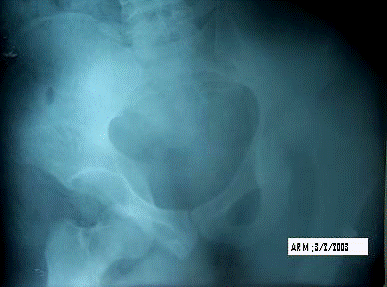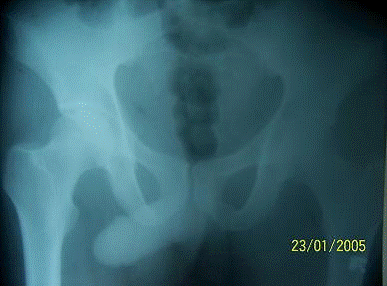|
Abstract:
Bilateral
traumatic dislocation of the hip joint is a rare combination.
Simultaneous asymmetric dislocation of the hip joints is even
rarer. Early diagnosis and treatment of traumatic hip
dislocation is essential to reduce morbidities that are commonly
associated with delayed reduction. We report a two year followup
of a case who presented to our hospital 3 days after sustaining
the injury. Closed reduction was successful. Two years after
sustaining the trauma the patient has mild pain in one hip and
no sign of avascular necrosis.
J.Orthopaedics 2008;5(1)e1
Introduction:
Dislocation
of the hip was once thought to be a rare injury. Due to the
increasing incidence and severity of road traffic accidents the
injury has become more common.[1,2]A hip dislocation is a major
injury in view of the large forces required to cause the
dislocation. Posterior dislocation of the hip is a commoner than
the anterior type with the anterior type constituting 10% of the
presentations.[2]. Simultaneous anterior and posterior traumatic
dislocation of both hips is even more unusual.[3].
Early diagnosis and treatment of traumatic hip dislocation is
essential to reduce morbidities that are commonly associated
with a delay in reduction.[4]
We
report a case with bilateral asymmetric [ windswept] dislocation
of the hip joints presenting 3 days after the injury. 2 years
after the reduction, the hips did not show any signs of
avascular necrosis.
Case
Report:
A
27 year old labourer fell from a tree while cutting its
branches. While falling he recalled that his right limb had
snagged in one branch breaking his fall to an extent. He had
fallen to the ground on the lateral side of his left leg. As the
area where he had sustained the injury is remote it took him
three days to report to our hospital. On admission, his right
leg was externally rotated, abducted and slight
flexed, while the left was held in fixed flexion,
internal rotation and adduction. A radiograph of the pelvis
showed that the patient had a bilateral traumatic assymmetrical
[ windswept] dislocation of the hips. The right hip had an
anterior dislocation with an indentation fracture of the femoral
head and the left side had a posterior dislocation. There was no
associated fracture of the acetabulum or femur. Both
hips were reduced within two hours of presentation by closed
manipulation under general anaesthesia. A radiograph after
reduction confirmed concentric reduction and excluded any
intra-articular fragmentsHe was kept on bed rest for two weeks
with skin traction followed by a further six weeks of
non-weightbearing. The patient reportedmonthly to our hospital
in view of the indentation of the right femoral head. At 2 years
the patient had mild pain of the right hip which did not
interfere with his routine activity. The radiographs did not
show any sign of avascular necrosis.
Discussion :
Dislocation
of the hip is an uncommon injury with every hip dislocation
being classified as an emergency.[5] Bilateral hip dislocation
occurring as a result of trauma is a rare condition.
Simultaneous anterior and posterior traumatic dislocation of
both hips is even more unusual. Traumatic dislocation of the
normal hip joint is rare because of its deep
acetabular cavity and strong surrounding ligamentous structures.
Ninety per cent of dislocations are posterior, occurring as
a result of high energy transfer mostly in car and motorcycle accidents (46% and 18% respectively). This results when a
sufficient force is applied in the long axis of the femoral
shaft while the hip is flexed and adducted. In contrast,
anterior dislocations are caused by rotation and may be
classified as superior and inferior. Superior ones occur
attributable to abduction and external rotation in extension and
inferior ones occur when the hip is adducted and external
rotated in flexion.[2].
Bilateral
hip dislocation in our case occurred due to the fall with the
anterior hip dislocation being caused by the branch forcing the
right hip into abduction and the ground reaction force being
transmitted through the adducted left limb. This
"windswept" mechanism is inconsistent with
the commonly accepted road traffic accident theory that an off
centre passenger cell intrusion directs longitudinal
force along both femora, yet has a vector in the
coronal plane. Our case had two separate trauma incidents in a
single fall.

Figure
1: Showing Assymmetric Dislocation Of The Hip Joints.

Figure
2: 2 Years After The Trauma There Is No Sign Of Avascular
Necrosis.
Several
studies have shown that the risk of osteonecrosis occurring
after a hip dislocation is related to the length of time
the hip remains dislocated. The risk rises after a delay of
six hours, or after repeated attempts at closed reduction. Overall,
the risk of developing osteonecrosis of the femoral head
after an anterior or posterior hip dislocation ranges from between
8% and 15%, to as high as 40% after operative treatment. [7,8]
Our
case demonstrates the fact that injury mechanisms might vary in
such complex presentations. Also delayed presentation in spite
of being a risk factor for increased complications does not
always preclude a good result.
Reference :
-
Armstrong JR; Traumatic Dislocation of
the hip joint. JBJS. 30-B; 430-445. 1948
-
Epstein HC. Traumatic dislocation of the
hip.
Baltimore
. Williams and Wilkins, 1980.
-
Hill RJ, Chmell S. Contralateral
anterior/posterior traumatic hip dislocations. Orthopedics
1990;13:87–8
-
Alonge
TO,
Ogunlade SO, Idowu OE. Traumatic dislocation of the hip joint--pattern and
management in a tropical African population. West
Afr J Med. 2002 Oct-Dec;21(4):288-90.
-
Vécsei V,
Schwendenwein E,
Berger G. Hip
dislocation without bone injuries.
Orthopade.
1997 Apr;26(4):317-26.
-
Upadhyay S, Moulton A. The long term results of traumatic
posterior dislocation of the hip. J Bone Joint Surg 1981;63B:548–51.
-
Upadhyay
S, Moulton A, Burwell R. Biological factors predisposing to
traumatic posterior dislocation of the hip. J Bone Joint Surg
1985;67B:232–6.
-
Epstein HC. Posterior fracture-dislocations of the hip: long
term follow up. J Bone Joint Surg 1974;56A:1103–27
|




